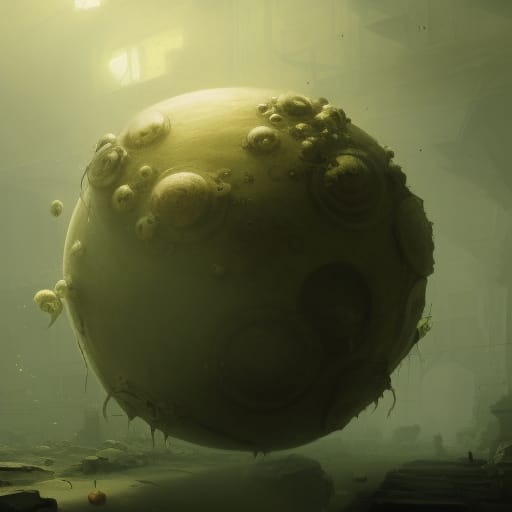Ascomoid, “The Rolling Sporebeast”
“This colossal fungus ball barrels through shadowy caverns like a living spore cannon, rolling over foes with leathery skin and spewing toxic clouds that choke and blind!”
Across the dank, echoing tunnels of the Underdark, the Ascomoid is a ten-foot–diameter, rolling sphere of leathery fungus that relentlessly pursues any tremor it detects, crushing or enveloping prey and spraying acidic or hallucinogenic spores to incapacitate foes before enveloping them in its living mass.
Appearance
Ascomoids resemble massive puffball mushrooms—ten feet across—with a tough, leathery rind colored mottled yellow-green and studded with hundreds of small “pock” organs that function as sensory pits.
Their spherical bodies weigh well over a ton (up to 2,600 lb), giving them enough mass to trample Medium and smaller creatures beneath their rolling bulk.
Each pock can, on command, gape open into a nozzle, capable of launching jets of acidic or psychoactive spores in a deadly defensive spore cloud.
Behaviour
Mindless and single-minded, ascomoids “hunt” by sensing vibrations: they roll toward any creature whose movement they detect within 60 ft, increasing speed from 3 ft on their first round to 12 ft on subsequent rounds—and they never tire of the chase.
When not actively pursuing prey, they remain rooted in damp cavern intersections, absorbing nutrients from soil and carrion, and sporadically ejecting spores that seed new mycelial growth.
Though indifferent to light, they prefer pitch-black, humid tunnels where their prey’s panic and movement trigger the ascomoid’s relentless advance.
Habitat
Ascomoids dwell exclusively underground, colonizing natural caves, dwarven mines, and drow warrens—any dark, moist environment with sufficient organic detritus to sustain their fungal metabolism.
They establish “nests” in cavern intersections where dripping water and decaying bones accumulate, using these nutrient pools to grow and reproduce via spore dispersal.
Rarely encountered on the surface, they may be found near sinkholes or collapsed ceilings where deep fungal networks breach the Material Plane.
Modus Operandi
- Roll and Crush: An ascomoid accelerates toward detected vibrations, using its mass to ram and knock prone any creature in its path—Medium or smaller targets are at greatest risk.
- Spore Jet: Once per round, it can expel a 30-foot line or 15-foot cone of highly acidic or hallucinogenic spores; affected creatures must make a Constitution save or suffer acid damage and debilitating effects (blinded, choking, or stunned).
- Engulf: If it rolls over a prone creature, it can envelop them within its fungal mass, dealing crushing damage each turn and attempting to digest the victim’s fluids into fungal tissue.
Motivation
Ascomoids exist solely to grow, spread, and consume—every action they take furthers their fungal imperative to convert living organisms into biomass and propagate spores throughout cavern networks.
Their relentless pursuit and devastating defenses make them natural guardians of deep Underdark environs, ensuring any trespasser becomes sustenance or soil for future generations of the monstrous fungus
Ascomoid 5e
Ascomoid, Pathfinder
Ascomoid
Medium Plant, Unaligned
Armor Class 15 (natural armor)
Hit Points 102 (12d8 + 48)
Speed 12 ft., roll 30 ft.
| STR | DEX | CON | INT | WIS | CHA |
|---|---|---|---|---|---|
| 18 (+4) | 14 (+2) | 18 (+4) | — | 11 (+0) | 1 (−5) |
Damage Resistances bludgeoning, piercing, slashing from nonmagical attacks
Condition Immunities blinded, charmed, deafened, exhaustion, frightened, prone
Senses tremorsense 60 ft., passive Perception 10
Languages —
Challenge 6 (2,300 XP)
Traits
- Round Body. The Ascomoid can’t be knocked prone, and it has advantage on saving throws against effects that would restrain or immobilize it; it takes a –4 penalty to checks to bull-rush or shove it.
- Tremorsense. Aware of vibrations in the ground within 60 feet, even in darkness or invisibility.
- Fungal Resilience. Immune to poison damage and the poisoned condition; resistant to acid and necrotic damage.
Actions
- Multiattack. The Ascomoid makes one Trample attack and can follow with one Spore Jet.
- Trample. Melee Weapon Attack: +8 to hit, reach 5 ft., one prone creature. Hit: 29 (4d10 + 7) bludgeoning damage. If the target is Medium or smaller, it is also knocked prone.
- Spore Jet. The Ascomoid expels a 30-foot line of acidic or hallucinogenic spores. Each creature in the line must make a DC 16 Constitution saving throw, taking 27 (6d8) damage (acid or poison) and suffering one of the following effects on a failed save (their choice per effect):
- Acidic Burn: The creature is blinded until the end of its next turn.
- Spore Cloud: The creature is poisoned and incapacitated until it uses an action to end the poisoned condition.
A successful save halves damage and prevents secondary effects.
Reactions
- Spore Burst. When the Ascomoid takes damage, it can release a 5-foot-radius burst of spores. Each creature in the area must succeed on a DC 16 Dexterity saving throw or take 13 (3d8) poison damage and be blinded until the end of its next turn (half damage and no blinded condition on a success). Recharge 5–6.
Legendary Actions
The Ascomoid can take 2 legendary actions, choosing from the options below. Only one legendary action option can be used at a time and only at the end of another creature’s turn. The Ascomoid regains spent legendary actions at the start of its turn.
- Detect. The Ascomoid uses Tremorsense.
- Roll. The Ascomoid rolls up to half its movement and may Trample one target it passes over (no extra attack roll).
- Spores (Costs 2 Actions). The Ascomoid uses Spore Jet (no recharge required).
Tactics
- Cavern Ambush: The Ascomoid lurks at tunnel intersections, remaining motionless until tremorsense detects intruders.
- Initial Engagement: It uses Spore Burst reaction or legendary Spores to disorient clustered foes.
- Charge & Crush: It rolls forward using Roll legendary action, Tramples prone targets, then retreats behind cover.
- Area Denial: It employs Spore Jet to carve safe corridors and force enemies into chokepoints.
- Relentless Pursuit: Nearly immune to restraining effects, it bull-rushes or shoves aside obstacles to follow fleeing prey.
This misshapen sphere of pale yellow-green fungus rolls with an unnerving speed, spewing clouds of foul spores as it advances.

Oversized fungi, ascomoids are frequently mistaken for giant puff balls until they begin to move, rolling toward any living prey that they sense. Once they have crushed the life out of a creature, they quickly move on, leaving spores behind in their victim’s body to grow new ascomoids. Ascomoids can grow to a width of 10 feet, but they rarely weigh more than 400 pounds.
While ascomoids require no light to grow, they do require a moist environment. They do not keep traditional lairs, but often wander the same areas over and over, littering these routes with the bones of past victims.
Although they are typically solitary creatures, ascomoids dwelling in areas of ample moisture with generous sources of food—or frequent unwitting passersby—sometimes form deadly clusters. Such colonies of these giant fungi often lurk in large caverns among other pallid vegetation. Given their ability to detect vibrations, the slightest quake or potential footfall sets them rolling, turning their cavernous lairs into churning meat grinders. Bounding about violently, groups of ascomoids sometimes take hours to settle back down, unable to distinguish between the movements of prey and the tumbling of their own kind. In some cases, ascomoids have been known to lair at the top of steep rises, crushing climbers as they roll in terrible fungal avalanches.
Those crushed by an ascomoid or who fall victim to an ascomoid’s spores face a revolting end, their bodies becoming hosts to quick-growing colonies of rampant fungi. Immature ascomoid mold sprouts quickly, typically appearing within 24 hours. After 48 hours, such victims become so overgrown with this furry, brown-green mold that they can no longer be restored to life by raise dead, as their bodies are too vitally pervaded and thoroughly consumed by the swiftly spreading mold. Within a month, a new ascomoid emerges from the foul mess.
Ascomoid CR 5
XP 1,600
N Large plant
Init +1; Senses tremorsense 60 ft.; Perception +0
DEFENSE
AC 17, touch 10, flat-footed 16 (+1 Dex, +7 natural, -1 size)
hp 52 (7d8+21)
Fort +8, Ref +3, Will +2
DR 10/piercing; Immune plant traits; Resist electricity 10, fire 10
OFFENSE
Speed 40 ft.
Melee slam +8 (2d8+6)
Space 10 ft.; Reach 5 ft.
Special Attacks poison, spores, trample (2d8+6, DC 17)
STATISTICS
Str 18, Dex 13, Con 17, Int —, Wis 11, Cha 1
Base Atk +5; CMB +10; CMD 21 (can’t be tripped)
Feats Improved OverrunB
SPECIAL ABILITIES
Poison (Ex)
Spores—inhaled; save Fort DC 16; frequency 1/round for 6 rounds; effect 1d2 Str damage; cure 2 saves. The save DC is Constitution-based.
Spores (Ex)
Once per round as a free action, an ascomoid can release a jet of deadly spores to a range of 30 feet. Upon impacting a solid surface, such as a wall or creature, the jet billows out into a cloud of spores that fills a 10-foot-radius spread. This cloud lasts for 1 round before dispersing. Any creature in the cloud must make a DC 16 Fortitude save or become nauseated as long as it remains in the cloud. Any creature that fails to save against this nausea is also exposed to the ascomoid’s poison (see above). The save DC is Constitution-based.
ECOLOGY
Environment underground
Organization solitary or cluster (2-8)
Treasure none
Section 15: Copyright Notice
Pathfinder Roleplaying Game Bestiary 3, © 2011, Paizo Publishing, LLC; Authors Jesse Benner, Jason Bulmahn, Adam Daigle, James Jacobs, Michael Kenway, Rob McCreary, Patrick Renie, Chris Sims, F. Wesley Schneider, James L. Sutter, and Russ Taylor, based on material by Jonathan Tweet, Monte Cook, and Skip Williams.

 Buy me a coffee
Buy me a coffee